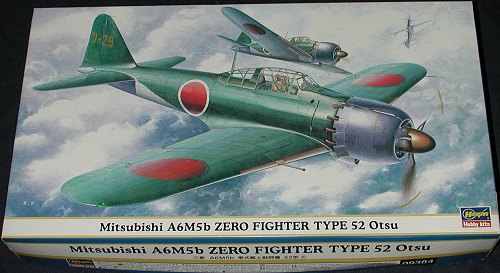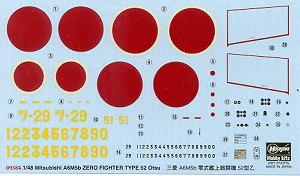
|
KIT: |
Hasegawa 1/48 A6M5b |
|
KIT # |
09384 |
|
PRICE: |
$25.98 MSRP |
|
DECALS: |
three options |
|
REVIEWER: |
Scott Van Aken |
|
NOTES: |
2001 issue |

|
HISTORY |
As any Allied pilot flying in the Pacific or CBI theaters who managed to shoot down or sight an enemy plane, and they'll say it was a Zero, even if there wasn't one for a thousand miles. That is how much the Mitsubishi A6M has been ingrained into our psyche. While the various versions of the Zero were the most widely produced Japanese aircraft, total builds or less than 10,000 aircraft were pale when compared to the Yak or 109, for which three times that number were produced. However, like those two aircraft, there were a rather bewildering number of different variants.
The final main version and probably most produced base airframe was the A6M5, which had shorter wings of greater cord and started incorporating some pilot armor and fuel tank protection that was sorely needed, though at a loss of range and maneuverability that the Japanese so loved. The A6M5b, the subject of this kit, was probably the best Zero made. It was the first to incorporate armored glass behind the windscreen, and had automatic fire extinguishers in the fuel tanks. On this version, one of the two cowl mounted 7.7mm machine guns was replaced with a 13.2mm version. It's first combat operation was an unmitigated disaster as it was heavily used in the Battle of the Philippine Sea (or Operation AGO, depending on your side of things). This version was later replaced by the A6M5c which further increased armament in the wings and a more powerful engine.
So, how to tell a b from an a or c? The easiest is to note the two wing gun barrels and the two different sizes of cowl gun openings.
|
THE KIT |
This kit continues the Hasegawa tendency to design a kit for a zillion different variants. Since the Zero is probably the biggest selling kit in the biggest market that Hasegawa has (Japan), it will probably surprise no one that they sell every one they make. Even the shelves here in the US are usually devoid of A6Ms as they tend to move pretty quickly.
The kit is all that we've come to expect from Hasegawa in that it has excellent surface detailing, a cockpit that is only marginally improved by a resin replacement, and a bunch of inserts to take care of the many different variants. Unusual in a modern Hasegawa kit is that there are no little poly-caps to hold in parts. However, this is a pretty straight-forward kit and one of the best that Hasegawa has done. A nice touch with this kit that is not on the early Zeros is that the flaps are a separate piece. This kit also includes the later drop tank without the fairing. In order to properly do this version, there is a touch of panel line filling and some additional engraving needed to get everything just right. Most of us won't have any trouble with this at all.
 Instructions are excellent
and provide all the color info you'd need. Color references are for Gunze
paints, just as they have been for decades. Decals are for two aircraft,
one from Tsukuba NAG in late 1944 as shown on the box art. The other is
from Suzuka AB in mid-1944. Both are pretty boring as color schemes go as
they are in the black green over light grey scheme. The box art plane
seems to be a Nakajima-build, judging from the 'swoop' of the lower camo
color to the tail plane underside, so if you are really into things,
you'll be using the Nakajima Naval colors for that one. I also noted that
the upper surface colors are wrapped around the leading edge of the wing
and go a short ways into the underside. Decals seem to be well done
and offer alternate tail numbers for the first scheme. There are also
instrument decals, which I use every time as they fit beautifully.
Instructions are excellent
and provide all the color info you'd need. Color references are for Gunze
paints, just as they have been for decades. Decals are for two aircraft,
one from Tsukuba NAG in late 1944 as shown on the box art. The other is
from Suzuka AB in mid-1944. Both are pretty boring as color schemes go as
they are in the black green over light grey scheme. The box art plane
seems to be a Nakajima-build, judging from the 'swoop' of the lower camo
color to the tail plane underside, so if you are really into things,
you'll be using the Nakajima Naval colors for that one. I also noted that
the upper surface colors are wrapped around the leading edge of the wing
and go a short ways into the underside. Decals seem to be well done
and offer alternate tail numbers for the first scheme. There are also
instrument decals, which I use every time as they fit beautifully.
|
CONCLUSIONS |
I can highly recommend this kit based on my most enjoyable experiences when doing some of the early model Zeros.
|
REFERENCES |
Japanese Aircraft of the Pacific War, by Rene J Francillon, 1979, Putnam.
If you would like your product reviewed fairly and quickly by a site that has nearly 250,000 visitors a month, please contact me or see other details in the Note to Contributors.